By Rocio Granados - La Voz Catolica
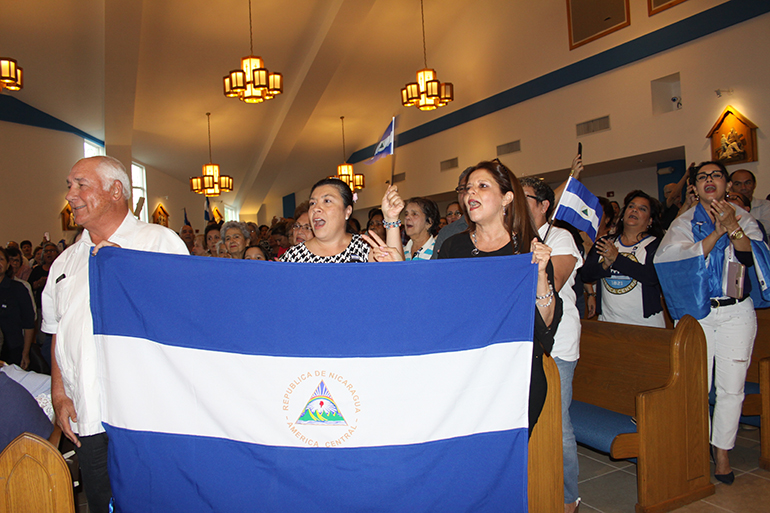
Photographer: ROCIO GRANADOS | LVC
Hundreds of Nicaraguans living in Miami gathered at Our Lady of Divine Providence April 26 to pray for their homeland after the recent protests that resulted in more than 50 dead and many more injured or disappeared.
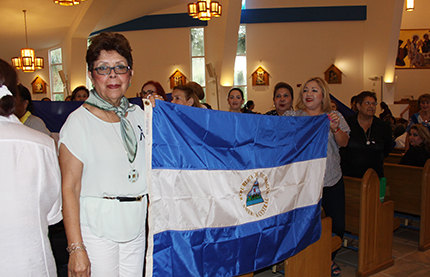
Photographer: ROCIO GRANADOS | LVC
Nicaragua-born Elba Vanigas and Maria Eugenia Salmo hold up flags in support of the families of those who died, were injured or disappeared during the recent protests in their homeland. They were among those who took part in the Mass for Nicaragua at Our Lady of Divine Providence Church in Sweetwater.
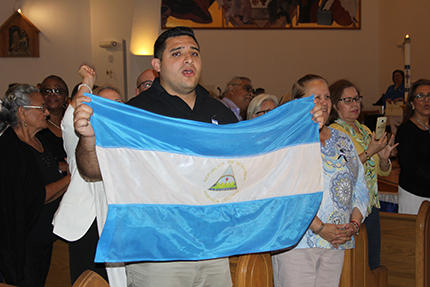
Photographer: ROCIO GRANADOS | LVC
U.S.-born Juan Suárez, a parishioner at St. John Bosco in Miami who was relatives in Nicaragua, takes part in the Mass urging peace, freedom and justice in the country.
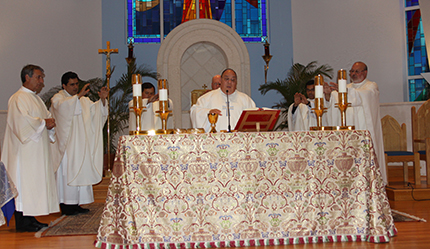
Photographer: ROCIO GRANADOS | LVC
Father Enrique Estrada, pastor of Our lady of Divine Providence Church in Sweetwater, concelebrates the Mass for peace in Nicaragua along with other Nicaraguan-born priests who serve in the Archdiocese of Miami.
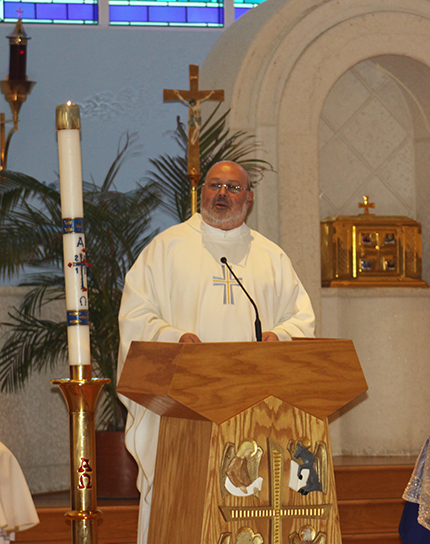
Photographer: ROCIO GRANADOS | LVC
Father Marcos Somarriba, pastor of St. Agatha Church in Miami, urges support for the young people fighting for a free Nicaragua during his homily at the Mass.
SWEETWATER | Waving their blue and white flags, hundreds of Nicaraguans, residents of Miami, got together April 26 at Our Lady of Divine Providence Church to pray for peace and an end to the violence in that country.
The Mass, organized by several archdiocesan priests of Nicaraguan origin, followed recent protests and riots in Nicaragua that resulted in more than 60 deaths, 160 people injured, and more than 10 missing, according to human rights organizations.
“I come to support the freedom of Nicaragua,” said Juan Suárez, a young parishioner of St. John Bosco Church, while the congregation sang the Nicaraguan anthem shortly before the Mass started. The U.S.-born Suarez said he has relatives in the Central American country.
“We have all seen the violent scenes that have come through social networks. Today we pray for peace, we ask for peace to reign, for violence to end and we pray for all the victims, for the ones that have died, the ones that have disappeared and all who were injured,” said Father Enrique Estrada, pastor of Our Lady of Divine Providence and one of the organizers of the event.
In his homily, Father Marcos Somarriba, pastor of St. Agatha Church and main celebrant, said: “Our prayer makes more noise than any gun or rifle that kills,” which sparked applause and cheers among the participants.
He cited some of the statements made by the Auxiliary Bishop Silvio Báez of the Archdiocese of Managua, who along with the leaders of the Nicaraguan Catholic Church have shown their support for the students and the protests.
Father Somarriba urged those present to pray for “these kids who have given their lives” for Nicaragua, for the Church, the bishops and priests who now face the challenge of mediation, and to not pemit the flame that has been turned on to be extinguished.
“What the youths have done is incredible because they are the ones who have awakened everyone. They started (to protest) for the elderly which induced the whole country to rise up,” said Maria Elena Calleja, a parishioner of Our Lady of Divine Providence. She said that the repression of the current government made her relive what she lived in Nicaragua many years ago, the reason why she emigrated to Miami.
Florida has the largest Nicaraguan community in the United States. They began arriving in the 1980s, during the Sandinista revolution that overthrew the dictator Anastasio Somoza Debayle, whose family had been in power for more than 50 years.
The attendance at the Mass “is a sign of the faith of the people. We all come looking to be consoled and we come filled with hope,” said Father Juan Carlos Paguaga, pastor of St. Agnes in Key Biscayne. “We can’t avoid seeing the happiness of the people, mixed with a little pain that is definitely present,” he added.
Also celebrating were Father Elvis Gonzalez, archdiocesan director of Vocations, Father Michael Davis, pastor of Little Flower in Coral Gables, and Father Yamil Miranda, parochial vicar of Blessed Trinity in Miami Springs.
Protests and repression
On April 18, after the government of Daniel Ortega announced a reform to the social security program that caused an increase in the contributions of workers, and a reduction in pensions for retirees, thousands of Nicaraguans, responding to a call by university students and private companies, poured into the streets of Managua, the Nicaraguan capital, to protest against the changes.
The national police repelled the protesters using tear gas and rubber bullets. The Sandinista Youth, a pro-governmental group, also went out to the streets to attack protesters and journalists, increasing the violence and repression.
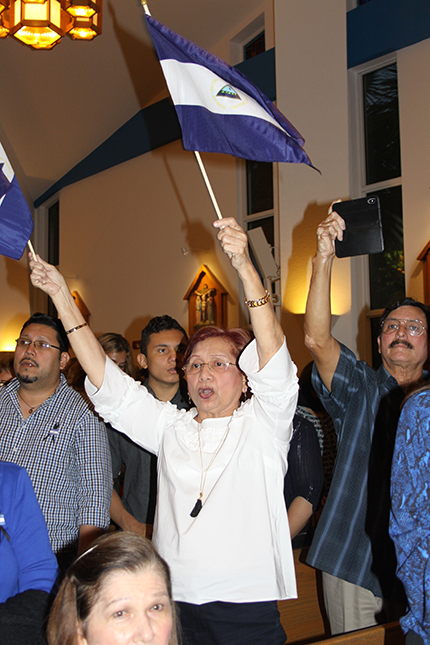
Photographer: ROCIO GRANADOS | LVC
Soveida Macrea de Zúñiga waves two Nicaraguan flags after the Mass for peace in that country. Macrea has lived in the U.S. since 1989, when earlier political conflicts caused her to leave her homeland.
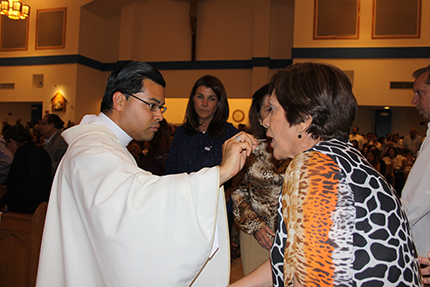
Photographer: ROCIO GRANADOS | LVC
Father Yamil Miranda, parochial vicar at Blessed Trinity in Miami Springs, gives Communion to María Elena Calleja during the Mass for peace and justice in Nicaragua that was celebrated at Our lady Divine Providence in Sweetwater, the city with the highest concentration of Nicaraguans in South Florida.
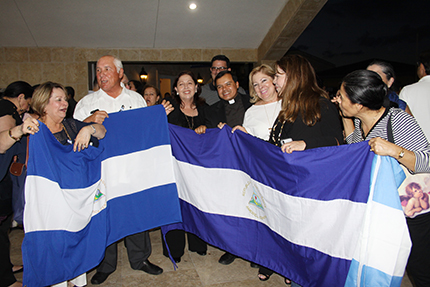
Photographer: ROCIO GRANADOS | LVC
Father Elvis González, director of Vocations for the Archdiocese of Miami, takes a photo with fellow Nicaraguans who attended the Mass for peace and justice in their country. The Mass was organized by Miami's Nicaraguan-born priests and celebrated at Our Lady of Divine Providence in Sweetwater.
The government initially minimized the protests, which in a few days spread throughout the entire country. Five television channels broadcasting the protests were taken off the air and journalist Ángel Gahona was killed while broadcasting on Facebook Live, covering a protest in Bluefields, on the east coast of Nicaragua.
Although a few days after the start of the protests the government revoked the social security reform, the protesters continued to demand an end to the repression, the release of the detained protesters, respect for human rights, freedom of expression and the exit of Ortega and his wife Rosario Murillo, who serves as vice president.
Ortega first came to power in 1979 as leader of the Sandinista Revolution. In 2007 he returned to the presidency, where he has remained after being re-elected in 2011 and 2016. Ortega is an ally of the Castros in Cuba and Nicolas Maduro in Venezuela. He is credited for Nicaragua’s stable economic growth and preventing the gang violence that afflicts neighboring El Salvador and Honduras.
According to some experts, the recent demonstrations are the biggest uprising in the country since the end of Nicaragua’s civil war almost 30 years ago.
“What we see right now is a social explosion, it’s the tip of the iceberg of a lot of problems that the people had been suffering in silence,” said Father Marlon Velásquez, a priest of the Diocese of Matagalpa, in Nicaragua, in a telephone interview with La Voz Católica.
According to the priest, Ortega’s government has not administered the pension system properly and now wants the people, amid a weakened economy, to pay for it. This is what caused the youths to explode.
“There are people who are being murdered in a clandestine way,” said the priest. They threaten or hurt them if they protest. But “the people have risen up. The fear is gone. If they're going to do something to you, it's worth it for these young people, who also gave their blood for Nicaragua. “
The priest pointed out that “the march is white and blue” and there are no politics involved. Those who come out to protest are the people who are saying, “Enough, do not continue to violate my rights.”
He added, “It’s a country that in the midst of its poverty still thinks, reasons and is able to take its history in its hands.
The role of the Church
Since the beginning of the protests, the role of the Nicaraguan Church has been to accompany, organize and pressure for dialogue.
“The Church has opened the door to the youths, giving them food and space. The priests have gone to take young men out of prison so they do not torture them, the nuns have come out to protest,” said Father González.
On April 25, Cardinal Leopoldo Brenes, archbishop of Managua, on behalf of the Nicaraguan Episcopal Conference, accepted an invitation for the Church to mediate a dialogue between the government, the private sector and the workers. He asked that “both the government and each member of civil society avoid all acts of violence, disrespect for public property and for an atmosphere of serenity and absolute respect for the life of each and every Nicaraguan.”
The Nicaraguan Church also called for a peaceful march to the Cathedral of Managua on April 28, to pray for “peace and justice,” for those who died, for the mothers of the deceased and for those who were injured during the confrontations. The march drew thousands of Nicaraguans, including people who came from other cities in the country.
Cardinal Brenes celebrated the Mass in which he pointed out the risks of mediating a dialogue that must conclude with agreements that satisfy the entire population. “We will do what we can for peace and justice to prevail and achieve the stability that the country needs,” said the cardinal.
For his part, Auxiliary Bishop Baéz said that “Nicaraguans need a better country and we will achieve it.”
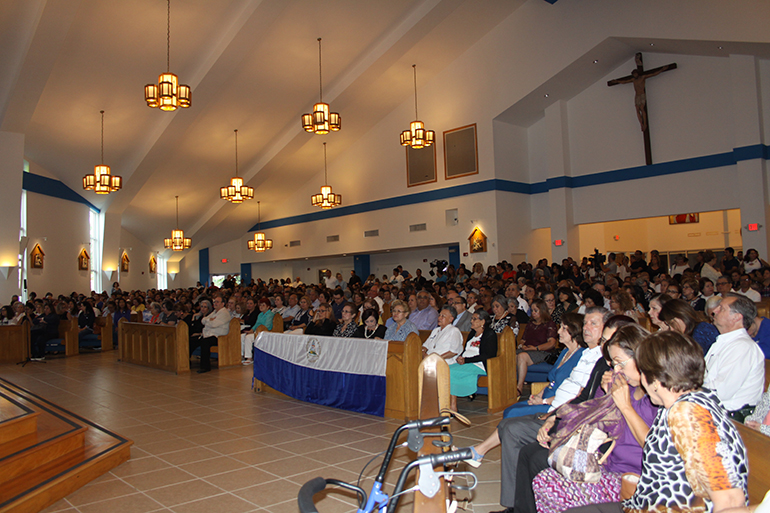
Photographer: ROCIO GRANADOS | LVC
Hundreds of Nicaraguans residing in Miami take part in the Mass for peace in their homeland, which was celebrated April 26 at Our Lady of Divine Providence Church in Sweetwater.

